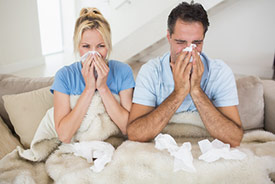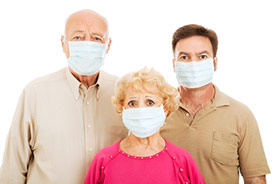Mold and Your Health – The Facts
 Mold is a four-letter word that no home or building owner likes to hear. They understand that it's a health risk, but they may be a little vague on the exact reasons. How much do you know about the nature and possible consequences of mold? Educating yourself about the dangers can help you take the proper precautions to prevent mold or deal with its appearance.
Mold is a four-letter word that no home or building owner likes to hear. They understand that it's a health risk, but they may be a little vague on the exact reasons. How much do you know about the nature and possible consequences of mold? Educating yourself about the dangers can help you take the proper precautions to prevent mold or deal with its appearance.
What Causes Mold?
Simply put, mold occurs in areas with high moisture content. However, that doesn't mean it has to come from a catastrophic event such as a leak or flood. Everyday activities like breathing release moisture into the air. Humidity measures the amount of water vapor in the air based on its total capacity.
While 100% humidity, or the dew point, means the air is totally saturated, mold and other decay can occur in conditions as low as 70% relative humidity (RH). Moisture will begin condensing on cooler surfaces such as bathroom ceilings and walls. The Environmental Protection Agency (EPA) recommends that indoor humidity be maintained at a level of 30 to 60% to inhibit mold growth.
What are the Physical Effects of Mold?
 In terms of its place in nature's cycle, mold is actually beneficial. It breaks down dead matter, returning valuable nutrients to the environment. You most likely have exposure to some type of mold almost every day without any negative effects. Problems develop from regular exposure indoors, where reduced ventilation allows a greater concentration of mold spores.
In terms of its place in nature's cycle, mold is actually beneficial. It breaks down dead matter, returning valuable nutrients to the environment. You most likely have exposure to some type of mold almost every day without any negative effects. Problems develop from regular exposure indoors, where reduced ventilation allows a greater concentration of mold spores.
The most common health-related issue resulting from mold is upper-respiratory ailments: wheezing; stuffy or runny nose; red, itchy, watery eyes. These symptoms can escalate into allergies and chronic sinus infections. If mold spores reach the lungs, it can result in asthma or allergic bronchopulmonary aspergillosis, a serious reaction to the Aspergillus fumigatus fungus.
On a more serious level, some molds produce a substance called mycotoxins. These metabolites are the cause of illnesses ranging from temporary irritation to cancer. Moldy food is a primary source of mycotoxins, and contact with skin can result in severe dermatosis. While the jury is still out on the threat of inhaled mycotoxins, the EPA recommends that you not take a chance and minimize any exposure.
How Do You Know if Mold is Affecting You?
 Not everyone reacts to mold the same way. Some people are extremely sensitive and suffer painful allergy attacks while others exhibit no symptoms. Don't rely on your physical condition to determine whether or not mold is at dangerous levels. Any appearance should be dealt with swiftly and thoroughly. Mold treatment doesn't have to throw your whole home or building into disarray. Our MoldExterm system offers a safe, comprehensive, cost-effective solution.
Not everyone reacts to mold the same way. Some people are extremely sensitive and suffer painful allergy attacks while others exhibit no symptoms. Don't rely on your physical condition to determine whether or not mold is at dangerous levels. Any appearance should be dealt with swiftly and thoroughly. Mold treatment doesn't have to throw your whole home or building into disarray. Our MoldExterm system offers a safe, comprehensive, cost-effective solution.
Don't Wait to Treat Your Mold!
Call us at 888-887-8376 when you are ready to get "STERN" With your mold! We offer a free mold inspection and price quote.
Photo Gallery
Seeing is believing! Take a peek at some of our recent MoldExterm client photos. You'll be amazed at how MoldExterm gets rid of serious mold problems fast without drywall tear out and significant downtime. See the MoldExterm Gallery Now!